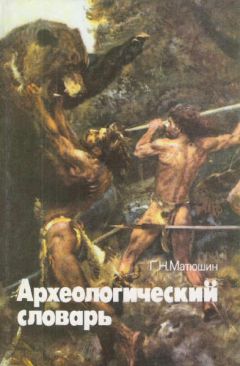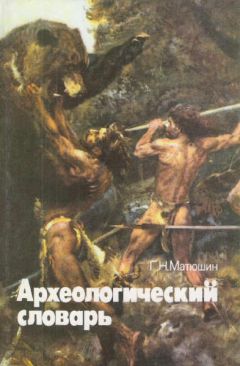Геральд Матюшин - У истоков человечества
Мюнциг А. Генетика общая и прикладная. М., 1967.
Неструх М. Ф. Приматология и антропогенез (обезьяны, полуобезьяны и происхождение человека). М., 1960.
Окладников А. П. Сибирь в древнекаменном веке. История Сибири, т. I. Л., 1968.
Подшибякин А. К. В ритме Солнца. — В кн.: Населенный космос. М., 1972.
Решетов Ю. Г. Природа земли и происхождение человека. М., 1966.
Рогинский Я. Я. Проблемы антропогенеза. М., 1977. 2-е изд.
Смагин Б. Чудо природы: естественный атомный реактор. — «Техника — молодежи», 1978, № 8.
Тих Н. А. Предыстория общества. Л., 1970.
Урысон М. И. Истоки рода человеческого в свете новейших данных. — «Вопросы истории», 1976, № 1.
Урысон М. И. Новый взгляд на ископаемых гоминид. — «Природа», 1980, № 10.
Фабри К. Э. Зоопсихология и антропогенез. — «Природа», 1973, № 2.
Фирсов Л. А. Поведение антропоидов в природных условиях. М., 1977.
Фирсов Л. А. В отрыве от своих. — «Наука и жизнь», 1979, № 12.
Хрисанфова Е. Н. О неравномерности морфологической эволюции гоминид. — «Вопросы антропологии», 1967, вып. 26.
Хрустов Г. Ф. Проблема человеческого начала. — «Вопросы философии», 1968, № 6.
Холодов Ю. А. Реакция организма животных и человека на магнитные поля. — В кн.: Проблемы космической биологии, т. XVIII. М., 1973.
Чижевский А. Л. Некоторые космические связи земной биосферы. — В кн.: Населенный космос. М., 1972.
Чижевский А. Л. Земное эхо солнечных бурь. М., 1973.
Шаллер Д. Б. Год под знаком гориллы. М., 1968.
Эйзенбад М. Радиоактивность внешней среды. М., 1967.
Якимов В. П. Некоторые проблемы становления человека на начальном этапе. — «Научные доклады высшей школы. Биологические науки», 1976, № 12.
Ancestors. Ed. by Willian H. Newell. The Hague — Paris, 1976.
Bauer К. Age Determination by Immunological Techniques of the Last Common Ancestor of Man and Chimpanzee. — «Humangenetic», 1973, 17, Heft 3.
Clark Howell F. Early Man. N.-Y., 1965.
Clark Le Gros W. E. Man-Apes or Ape-Men? London, 1967.
Clark Le Gros W. E. The Antecedents of Man. London, 1970.
Cox A. Geomagnetic reversals. — «Science», 1969, vol. 163.
Earliest Man and Environments in the Lake Rudolf Basin. Chicago, 1976.
Eimerl S. and De Vore I. The Primates. N.-Y., 1965.
Goodall van Lawick J. The Behaviour of Chimpanzees in Their Natural Habitat. — «American Journal of Psychiatry», 1973, vol. 130, N I.
Goodall J. Chimpanzee Behaviour. — Hominisation und Verhalter. Bonn, 1975.
Howells W. Evolution of the Genus Homo. Reading, Mass., 1973.
Itani J. and Suzuki A. The Social Unit of Chimpanzees. — «Primates», 1967, vol. 8, N 4.
Itani J. Evolution of Primate Social Structure. — «Journal of Human Evolution», 1977, vol. 3.
Jolly C. J. The seed eaters. — «Man», 1970, vol. 5, N I.
Kortland A. How do chimpanzees use weapons when fighting Leopards? — Yearb. Amer. Phil. Soc. N.-Y., 1965.
Leakey L. S. B., Tobias P. V., Napier J. R. A new species of the genus Homo from Olduvai Gorge. — «Nature», 1964, vol. 202, № 4927.
Leakey M. D. Olduvai Gorge. Vol. 3. Excavations in Beds I and II, 1960—1963. Cambridge, 1971.
Lumley H.de. A Paleolithic Camp at Nice. — «Scietific American», vol. 220, 1969, N 5.
Mc Grew W. C. Man as tool maker meets a rival. — «Anthropos», 1976, t. 4.
Mann A. E. Hominid and cultural origins. — «Man», 1972, vol. 7.
Napier J. R. and Napier P. H. A Handbook of living primates. London, 1967.
O'Brien E. M. The Projectile Capabalitied of an Acheulian Handaxe from Olorgesailie. — «Current Anthropology», 1981, vol. 22.
Papamarinopoulis S. The death of the dinosours by ultraviolett radiation of the planet during the geomagnetic reversals period. — «Anthropos», 1977, vol. 4, N 1—2.
Pilbeam D. The ascent of man. N.-Y., 1972.
Reynolds V. The apes: the gorilla, chimpanzee, orang—utan and gibbon—their history, tables, bibliogr. London, 1968.
Sarich V. A malecular approach to the question of human origins. — Background for man. Boston, 1971.
Shaller G. В., Emlen J. T. Observations on the ecology and social behaviour of the mountain gorilla. — African ecology and human evolution. Chicago, 1963.
Simpson G. G. The Meaning of Evolution. London, 1955.
Solecki R. S. Shanidar the First Flower People. N.-Y., 1971.
Tobias P. V. New african evidence on the dating and the phylogeny of the Plio — Pleistocene Hominids. — Quaternary Studies. Selected papers from IX INQUA Congress. Wellington, 1975.
Vore I. de., Washburn S. L. Baboon ecology and himan evolution. — African Ecology and Human Evolution. Chicago, 1963.
Vore I. de., ed. Primate behaviour. N.-Y., 1965.
Washburn S. L. The Study of Human Evolution. N.-Y., 1968.
The Dawn Of Mankind
Analyzing the natural conditions that characterized the cradle of Mankind the author comes to the conclusion that the generally accepted theory where the decisive role is played by the climate and vegetation in the first emergence of Mankind does not allow to explain the entire originality of anthropogenesis. The climate and vegetation have changed repeatedly and periodically, but it did not lead to the humanization of apes, even the chimpanzee — that is very close to Man.
For the first time in this book specific peculiarities of the prehomeland of Mankind are determined (rifts, volcanoes, earthquakes, concentration of uranium deposits). The author traces the coincidence of the active manifestation of these peculiarities of the environment and changes in the biology of the anthropoids that lived there and sets forth a hypothesis that there is a connection.
The author assumes that riftogenesis and the tectonic intensity lead to baring of uranium rocks and to the formation of natural reactors of the Oklo type. Growth of the volcanic activity caused massive effusion of radioactive magma (almost all of the remains of preman and early man are covered by and mixed with volcanic deposits). A series of geomagnetic inversions that intensified cosmic radiation took place at the time of the emergence of Man from the Animal Kingdom (Gilberth and Gauss epochs). The combined impact of different factors formed zones of higher radiation in Western and Southern Africa.
Radiation lead to the reduction of the number of chromosomes from 48 (contemporary anthropoides) to 46 (Man) in embryonic cells of anthropoides and to other transformations of the hereditary structure of the DNA. (Adhesion of chromosomes due to radiation is confirmed by experiments.) Mutations caused the growth of the volume of the brain, changes in the structure of the scull and other parts of the skeleton of the preman, that made him to acquire an erect walking.
The preman that came into being as a result of mutations lost his acute fangs and other biological means with the help of which apes search for food, and thus he was doomed to die. But the transformation from a random use of implements (as chimpanzees do) to a systematical (that is reflected in the appearance of stone tools) gave Man the possibility to survive.
Work was the only possibility for the ancestors of Man to survive, which is demonstrated by the extinction of the Australopithecus africanus the nearest relative of the Homo habilis, who as the latter had the walk erect and the same volume of the brain, but did not make stone tools.
Иллюстрации
Река Омо, на ее берегах все выглядит почти так же, как и 2,6 млн. лет назад, когда здесь обитали австралопитеки и человек «умелый»
Лотэгем. Небольшое ущелье. Здесь под бурыми слоями озерных отложений были найдены останки австралопитека африканского (предчеловека), жившего около 5,5 млн. лет назад
Олень (?) из пещеры Ляско — рисунок палеолитического человека
Голова быка из Ляско (палеолит)
«Венера» из Ляссели (Франция). Изображение вырублено на камне первобытным человеком около 20 тыс. лет назад
Одно из самых крупных каменных орудий — ашельский кливер со стоянки Исимила в Танзании. (Длина — 25 см. Это и другие такие же крупные орудия найдены вместе с остатками разделанных туш гиппопотама.)
Орудия из яшмы и хрусталя со стоянок Урала
Наконечники копий и стрел со стоянок Урала
Вид на южноуральскую реку неподалеку от Каповой пещеры
Эволюция техники в каменном веке. Спираль — длина режущего края, получавшегося от 1 кг кремня: в раннем палеолите (голубой и зеленый), в мустье (черный цвет) и в верхнем палеолите (красный цвет). Количество ударов (кружки) и операций (группы кружков), приходящихся на изготовление орудий
Эволюция жизни на Земле
Группа австралопитеков бредет по саванне в поисках добычи и кореньев. (Австралопитеки занимались не только собирательством, но и охотой.)
Австралопитеки за изготовлением орудий и другими занятиями (фигуры австралопитеков реконструированы по их скелету)
Череп неандертальца из пещеры Шанидар. (Вид в профиль и фас. Около левого глаза череп пробит. Видно, что рана зарубцевалась при жизни.)
Родословное древо человека в представлении различных специалистов
Дэвид Серебробородый — друг вожака Голиафа
Шимпанзе специальным прутиком вылавливают насекомых
Шимпанзе с детенышами
Бабуин-вожак демонстрирует свои острые клыки
Олдувайское ущелье
Колыбель человечества. Зоны обитания шимпанзе и горилл. Зоны вулканизма, рифта и урана (1 — Таунг; 2 — Олдувай; 3 — Кооби-Фора; 4 — рифты; 5 — зона землетрясений и активного вулканизма; 6, 7 — ураноносные месторождения)
Методы определения родственности человека и обезьян
Вид африканской саванны
Вид на озерную стоянку каменного века на Урале
Раскопки стоянки каменного века в Средней Азии
Стенка раскопа. (Зола (вверху) — следы очага, который горел около 2 тыс. лет назад. Ниже — слои почвы с остатками поселений шеститысячелетней давности.)




